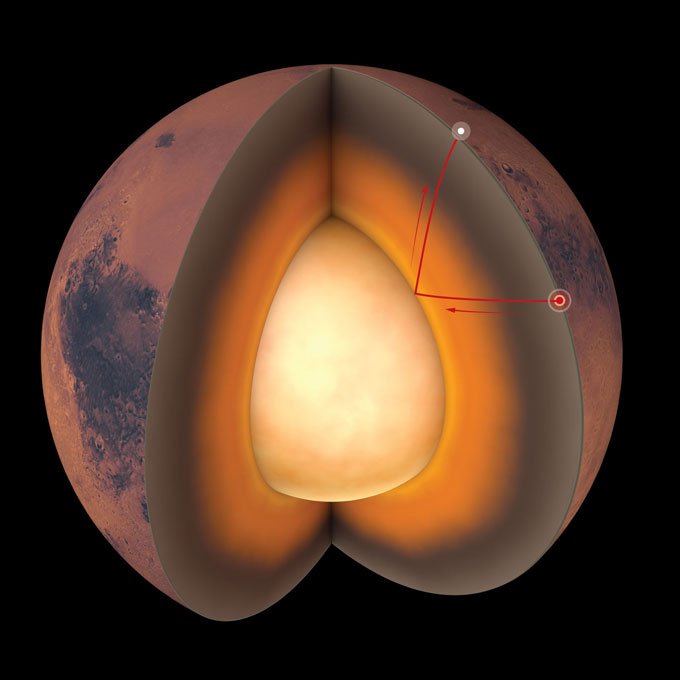Mars has had its first CT scan, because of analyses of seismic waves picked up by NASA’s InSight lander. Analysis: The Crimson Planet’s core is not less than partially liquid, as some earlier research had recommended, and is considerably bigger than anticipated.
InSight reached Mars in late 2018 and shortly afterward detected the primary recognized marsquake (SN: 11/26/18; SN: 4/23/19). Since then, the lander’s devices have picked up greater than a thousand temblors, most of them minor rumbles. Lots of these quakes originated at a seismically lively area greater than 1,000 kilometers away from the lander. A small fraction of the quakes had magnitudes starting from 3.0 to 4.0, and the ensuing vibrations have enabled scientists to probe Mars and reveal new clues about its interior construction.
Simon Stähler, a seismologist at ETH Zurich, and colleagues analyzed seismic waves from 11 marsquakes, in search of two kinds of waves: stress and shear. In contrast to stress waves, shear waves can’t cross by means of a liquid, and so they transfer extra slowly, touring aspect to aspect by means of strong supplies, fairly than in a push-and-pull movement in the identical course a wave is touring like stress waves do.
Signal Up For the Newest from Science Information
Headlines and summaries of the most recent Science Information articles, delivered to your inbox
Of these 11 occasions, six units of vibrations included shear waves robust sufficient to face out from background noise. The energy of these shear waves means that they mirrored off of the outer floor of a liquid core, fairly than getting into a strong core and being partially absorbed, Stähler says. And the distinction in arrival occasions at InSight for the stress waves and shear waves for every quake recommend that Mars’ core is about 3,660 kilometers in diameter, he and colleagues report within the July 23 Science.
That’s somewhat greater than half of the diameter of all the planet, bigger than most earlier estimates. The Crimson Planet’s core is so massive, in actual fact, that it blocks InSight from receiving sure kinds of seismic waves from a big a part of the planet. That, in flip, means that Mars could also be extra seismically lively than the lander’s sensors can detect. Certainly, one of many areas within the lander’s seismic blind spot is the Tharsis area, dwelling to a few of Mars’ largest volcanoes. Volcanic exercise there, in addition to the movement of molten rock inside the crust in that area, might set off quakes or seismic waves.
 Seismic waves (purple strains on this illustration) touring by means of Mars from a quake’s supply (instance, purple dot) to the InSight lander (white dot) reveal the Crimson Planet’s inner construction, together with a large core (yellow-white) greater than half the diameter of the planet.Chris Bickel/Science
Seismic waves (purple strains on this illustration) touring by means of Mars from a quake’s supply (instance, purple dot) to the InSight lander (white dot) reveal the Crimson Planet’s inner construction, together with a large core (yellow-white) greater than half the diameter of the planet.Chris Bickel/Science
Whereas the newly analyzed information verify the planet’s outer core is liquid, it’s not clear but whether or not Mars has a strong interior core like Earth, says examine coauthor Amir Khan, a geophysicist additionally at ETH Zurich. “The sign needs to be there within the seismic information,” he says. “We simply must find it.”
In a separate evaluation additionally printed in Science, Khan and colleagues recommend that InSight’s seismic blind spot may stem, partially, from the way in which that seismic waves decelerate and bend as they journey deep inside the planet. Adjustments in seismic wave velocity and course may result from gradual variations in rock temperature or density, for instance.
Mars’ seismic waves additionally trace on the thickness of the planet’s crust. As they bounce forwards and backwards inside the planet, the waves bounce off interfaces between completely different layers and kinds of rocks, says Brigitte Knapmeyer-Endrun, a seismologist on the College of Cologne in Bergisch Gladbach, Germany. In a separate examine in Science, she and her workforce analyzed seismic alerts that mirrored off a number of such interfaces close to Mars’ floor, making it tough to find out the depth at which the planet’s crust ends and the underlying mantle begins, she says. The researchers concluded, nonetheless, that the common thickness of the crust possible lies between 24 and 72 kilometers. For comparability, Earth’s oceanic crust is about 6 to 7 kilometers thick, whereas the planet’s continental crust averages from 35 to 40 kilometers thick.
Collectively, these seismic analyses are the primary to analyze the innards of a rocky planet aside from Earth, Stähler says. As such, they supply “floor reality” for measurements made by spacecraft orbiting Mars, and will assist scientists higher interpret information gathered from orbit round different planets, akin to Mercury and Venus.
The findings might additionally present insights that may assist planetary scientists higher perceive how Mars fashioned and developed over the lifetime of the photo voltaic system, and the way the Crimson Planet ended up so unalike Earth, says Sanne Cottaar, a geophysicist on the College of Cambridge. Cottaar wrote a commentary, additionally printed in Science, on the brand new analysis. “Mars was put along with comparable constructing blocks” as Earth, she says, “however had a unique end result.”



